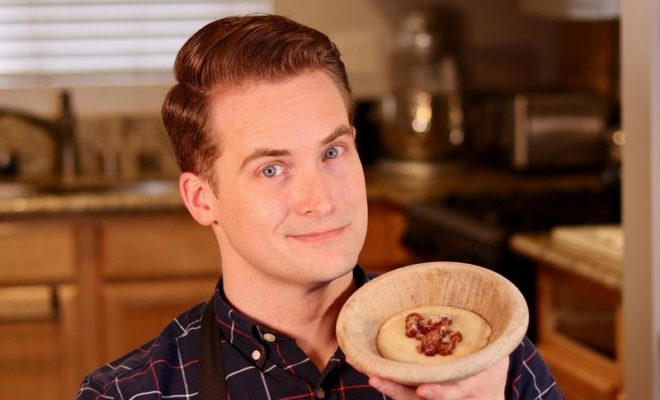
Interviews
Max Miller – Tasting History
By: Jennifer Vintzileos
Q) Where did your love of historical cuisine come from and how did you decide to use it to develop the concept of “Tasting History?”
A) My love of historical cuisine came from watching the early seasons of “The Great British Bake Off.” They used to have these short segments where the hosts, Mel and Sue, would talk about the history of one of the bakes that the contestants were making that week. It was informative and charming and had their own brand of irreverent, pun-infused humor. Food, history and funny all in one. That inspired me to make the dishes they discussed, which led me to fall down the rabbit hole of historical cuisine. When a friend at work suggested I put the dishes I was making on YouTube, I thought back to those segments and decided to make something that would rekindle the feeling those segments gave me. Food and history but taking neither too seriously.
Q) Prior to “Tasting History,” you were furloughed from your job at Walt Disney Studios. How did your work experience help you in the production aspect of the show?
A) It helped me immensely. While I never did any production or editing in my job, I worked closely with some of the top editors in the world. I got to see a bit of their process as I watched a trailer develop from version 1 to version 4, then 14, all the way up to the finished product that went in theaters which could be version 55B or higher. I didn’t really think about it then, but when I started editing my own scripts and episodes I definitely mimicked some of the techniques that I’d seen evolve in those trailers. What I wish I’d paid more attention to was the lighting and actual production quality, but since I worked in post-production, I didn’t have as much access to that, so those first episodes were a steep learning curve.
Q) I watched the episode about Loseyns and could not wrap my head around making Lasagna with cinnamon and sugar! What would you consider the strangest recipe you tried?
A) I think the strangest recipe I’ve tried is a Renaissance recipe for a cheese and herb tart meant to be served to a Pope. While it has flavors that we’d associate with that kind of dish, it’s also filled with cinnamon, clove and sugar just like the medieval Lasagna. It ends up coloring the filling in a way, so it looks like mock ground beef. It was a fantastic flavor, but jarring and completely incongruous with what you’d expect to taste today. Perhaps it’s something that could make a comeback though.
Q) For future episodes, which style of cuisine would you love to make and discuss that you haven’t yet?
A) I’d love to cover Native American cuisine, especially that of North America. So many of our modern foods rely on the ingredients that the “New World” offered, but the people who introduced them to the European settlers rarely get to have their cuisine featured today. Often, we think of the cuisine as a monolith, if we think of it at all. But in the little research that I’ve done, I’ve found it to be just as varied as that of the many countries of Europe. I hope to partner with some creators who know the cuisine and the history. It’s an important part of our past that is so often overlooked.
Q) Your show is quite reminiscent of Alton Brown’s “Good Eats,” who you consider as one of your inspirations. If you could do an episode with Alton Brown, what dish would you love to recreate and discuss with him?
A) If Alton Brown wanted to do an episode with me, I would be foolish not to let him choose the dish. Learning from him would be too great an opportunity to pass up. But if I had to choose, I think I’d go with barbecue. It’s such a simple concept, but it has so much variety in techniques and flavors and such a long history that I think it’d be something we could really explore at length. Plus, Alton is so well versed in the science of food and the process of cooking barbecue would elicit so many questions to which I just know he’d have the answers.
Q) Are there any recipes you liked so much that you added them to your cooking repertoire?
A) Absolutely! I think the real stand out is syllabub. It’s basically flavored, boozy whipped cream. It’s very easy, so delicious and has endless possibilities for variation. Change up the liquor, change up the flavorings, add it to cakes or fill pastry with it. It tops my list and I hope to see it in restaurants soon.
Q) Have you considered writing a book about historical cooking?
A) I have. I actually have been meaning to write a proposal, but pumping out an episode a week has really kept me busy. I’m getting ready to go on a vacation though so I plan to take a little time and think about what the book would look like. Obviously, there would be recipes, but I also hope to transfer the little historical anecdotes that I love on the show to a written format.
Q) Your videos focused on the cookbook The Forme of Cury were quite informative and fun to watch. If someone was looking to explore historical cooking, which cookbooks would you consider your Top 3 to recommend for reading?
A) The Forme of Cury is a great place to start; it’s where I started. Then, I’d also recommend Apicius’s De Re Coquinaria which covers recipes from Ancient Rome, many of which are still accessible to us today… and many of which are not. Lastly, everyone should pick up Eliza Acton’s Modern Cookery for Private Families from 1845. She writes her recipes in a way that would allow anyone today to recreate the dishes. Many of the dishes are something we would recognize today, but with just enough differences to make you take a second thought before you bite into it.
Q) When things eventually do get better, do you have any plans to take episodes of “Tasting History” overseas to visit the origins of the dishes you discuss?
A) It’s what I’m most excited about. I want to visit the places that I talk about and learn from people who are well versed in the cuisines. There are also ingredients that you just can’t get in America. Besides, it’d be a great excuse to travel which is my favorite thing to do.
Q) Aside from a vast knowledge of historical cooking, I also learned you love to sing! Do you sing while you cook and if so, what are some of your go-to songs while you cook?
A) I do love to sing; it was my profession for many years. When I sing as I cook, it’s mostly songs where I replace the lyrics with gentle admonishments of my cats as they interfere with the process. As far as which songs you may hear coming from my kitchen, it can run the gamut from English Renaissance madrigals to Motown to Lady Gaga. I actually find that Led Zepplin also provides a nice repertoire while creating 15th century delicacies.
Q) The little quips and Dad jokes have kept each episode quite light and entertaining. Tell us your best “Dad joke.”
A) Why can’t a nose be 12 inches long?… Because then it would be a foot! I’ll show myself out…
Q) What would you like to share with fans and viewers of your show?
A) I’ll share something I’ve learned from this endeavor. Follow your passion and create things even if you don’t think anyone will care. Producing “Tasting History” has been one of the most rewarding experiences of my life and I almost didn’t do it because I thought it was a dorky concept and that nobody would watch. I’ve learned that if something interests you, then it’s sure to interest other people too.



You must be logged in to post a comment Login